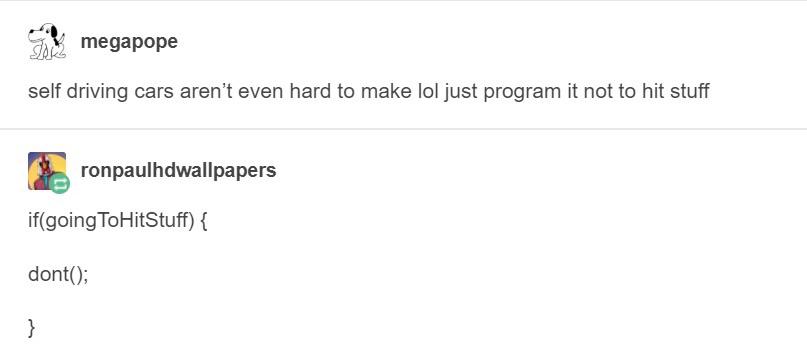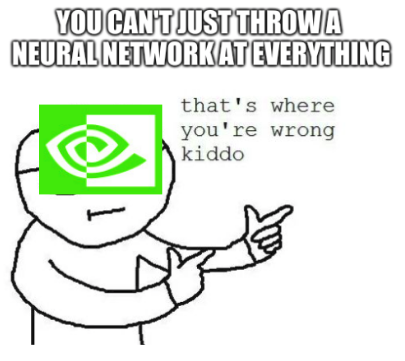Over the next couple of months, I want to make a self-driving car. Okay, I know that sounds really fancy,
and honestly even I am not sure how much of a success how big a failure it will be, but there’s no harm
in trying, and it will be a learning experience either way. I have decided to share this journey with the
world through my personal blog so keep following me over the next couple months to see how far I can go. And
if you have any suggestions to help me along the way, I’m all-ears! I am doing taking up this challenge with
the goal of learning, after all. (Learning what, you ask? I will be able to tell you only after I am done
with this project.)
Turns out, programming a self-driving car is not as difficult as all the big companies make it seem:

In all seriousness though, we need to have a solid plan about how we are actually going to make the self-driving car. First, let’s clearly define the scope of this project; after all, people have wildly different ideas about what constitutes a self-driving car.
Goal
The ultimate goal of this project is to build a self-driving RC car (1/10th scale) that will be able to compete in the DIY Robocars Oakland races. You can check out the links for more information, but here is a summary: about once every 2 months or so a bunch of smart people who’ve made their own self-driving RC cars meet up in a warehouse in Oakland and race their creations. Since I happen to live only about 12 miles from there, I have no reason not to go there.
So I will call this project a success only when I successfully make a self-driving car that is able to meaningfully compete in one of those races.
How to get there
Now that we have a clear picture of what I want to do, let’s break this problem down into simple, tangible parts that can be coded or built.
Hardware
As a simplification, I have decided not to worry too much about hardware until the software is ready. The only thing I can say with certainty at this point about the hardware is that it will be a 1/10th scale RC car with a single-board computer onboard (a Raspberry Pi or some slightly more powerful board) along with a camera and an IMU. As for LIDAR, I am not sure whether I will need it or not, and I certainly don’t want to buy a LIDAR sensor right now only to find out later that I don’t need it, so I am going to take care of the software side first.
Software
On the software side, we have two tasks: steering the car and setting the throttle. Contrary to what some of you might think, I will not use just a neural network to steer the car and set the throttle of the car, because it is impossible to make a neural network that can take in raw images and output steering angles.

Actually, Nvidia showed in this paper and this blogpost that end-to-end neural networks can do just that–take in raw images and output steering angles. But it is not exactly a good idea to just throw a neural network at every problem. This is because neural networks are complicated functions and their behavior is pretty much impossible to predict when it encounters an input that is far from the training data, i.e., there is no easy way to predict how a neural network will extrapolate beyond the training data, even if it can reliably intrapolate. For example, if we train a neural network to drive a car in a track, we will have no idea about how it will behave on a different track until it actually drives on it. In fact, given training data that is biased enough, neural networks can learn to pick up non-obvious objects surrounding the track (look here for a neural network that learned to steer whenever it saw a particular table next to the track).
On the other hand, if we make a lane-detecting algorithm, we will know for certain that it will behave just as reliably on any track as long as the lane lines are visible. However, such feature-engineering has its own drawbacks, namely the inability to generalize. While making such an algorithm, we must come up with and handle all possible cases that the algorithm will encounter, because if it encounters a situation that we did not consider, we know exactly what will happen: it won’t work.
So we need to find some middle-ground, some Goldilocks zone between an end-to-end deep learning model and a pipeline consisting of feature-engineering only, which will combine the best of both worlds. This will be the primary challenge of this project.
I have decided to approach this by starting with some feature engineering for finding lanes and other objects in the scene and then helping the model generalize using reinforcement learning (RL). I will use the CARLA simulator (version 0.8.2, the stable release) to train my RL models. Then I will test my models using both the CARLA simulator and the donkeycar simulator, which has tracks that more accurately represent the environment in which the donkeycar Oakland races are held. CARLA is great because not only does it have all kinds of sensors like cameras, IMUs and LIDAR, but it also allows the user to choose between multiple weather conditions and simulates other vehicles (cars, trucks) on the road and pedestrians crossing the roads. And on top of all that the simulator detects when the car hits another object and gets out of its lane; these can be important reward signals for reinforcement learning.
Making a lane detector is not a very complex problem. The Udacity self-driving car nanodegree includes exactly that as their fourth project, so there are no less than a dozen GitHub repos that contain code for lane detection (just google it or search it up on YouTube). In fact, once you understand all the concepts involved, it can it can be implemented in an afternoon. At this point, I would suggest you watch a video on that or read through some blogpost that explains the pipeline, otherwise the following might not fully make sense.
The biggest problems with the “advanced lane detection” algorithm are that:
- the perspective transform fails if the camera tilts (due to linear acceleration or turning)
- the algorithm can fail at hairpin bends and sharp turns in general if the lanes turn back into the camera frame
- the algorithm assumes that there is a single lane bounded by two lines
- the algorithm has no way to detect other vehicles, and even fails to detect lanes when another car blocks its field of view
I can think of the following solutions to these problems (in order):
- Assuming that the camera and the IMU are rigidly attached to the car, we can determine the tilt of the camera tilt measurements from the IMU and factor that into the perspective transform that is applied to the image.
- One way I can come up with to solve this problem is to somehow change the region of interest depending on the scene, but it is not obvious to me how we can do that. Maybe we can use deep learning for this? I am actually looking forward to suggestions in the comments about this.
- This may or may not be a problem depending on the rest of our code (I will look into this later).
- In order to detect other vehicles, we can use an object detector like a YOLO neural network, but it is not
trivial (and impossible without some sort of calibration) to figure out how far the detected vehicles are.
Finding the lanes when blocked by some vehicle/object will require some sort of simultaneous localization and
mapping (SLAM) algorithm in order to synthesize information from previously seen frames (because any given
section of the track will be captured in multiple consecutive frames and be visible in at least some of them
even if it is blocked in some others; think about how you drive when there is a box truck right in front of
you on the highway).
- There is another way to deal with the problem of having other vehicles blocking our path: semantic segmentation. If we have enough computing power, we can use semantic segmentation to determine which parts of the camera feed are road and use it to find lane lines as well, which can then be fit using the vanilla lane detection algorithm, and combined with SLAM to deal with situations when other vehicles block our field of view.
Plan
So here’s what I am going to be doing next:
- Implement basic lane detection, while simultaneously training a neural network for semantic segmentation (I haven’t decided which architecture yet). CARLA has semantic segmentation built in, so it will make it much simpler to train the neural network.
- Implement a SLAM algorithm to keep the car within its lane at all times as well as reliably find the center of the lane even when the lane lines are not completely visible.
- Plan what to do next.
In the coming days I will work on all this and keep y’all updated on this blog, so please come back soon! Future posts will be more like tutorials and all the code for this project will be available on my GitHub. (I will make the repo later, so make sure to check out my next blog post!) Also feel free to leave any comments/suggestions that you might have for me. I am only starting to blog, so I probably have a lot to learn. And while I have some knowledge of robotics, I am no expert in this field, so please tell me if I am doing something stupid. Finally, please share this with people who might be interested in content like this as it will help me (and they might also end up learning something new!).